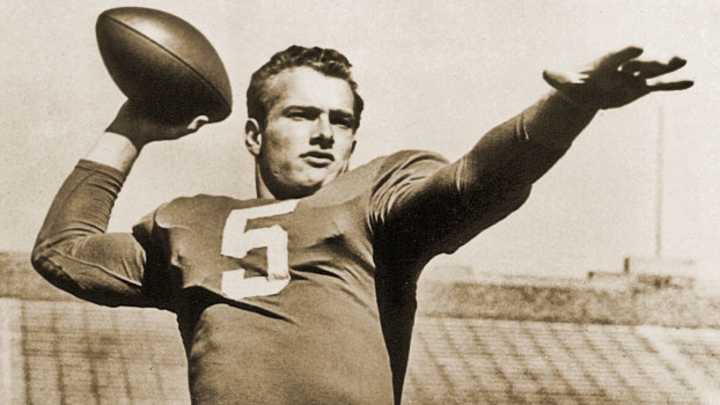RIP Paul Hornung: When Notre Dame’s 'Golden Boy' played the Oklahoma Sooners

Paul Hornung, Notre Dame’s 1956 Heisman Trophy winner, died Friday at the age of 84.
Hornung’s career with the Irish (1954-56) did not coincide with any of the program’s elite teams. In Hornung’s three seasons playing for Terry Brennan, the team went 9-1, 8-2 and 2-8.
In those same three seasons, Oklahoma never lost a game under Bud Wilkinson, finishing 10-0, 11-0 and 10-0.
They did cross paths once, however — unfortunately for Hornung and the Fighting Irish, it was that 1956 season, when the Sooners were untouchable and the Irish were lousy.

OU was the defending national champ after outscoring teams 385-60 in 1955. The Sooners’ last loss had come in the 1953 season opener against Frank Leahy’s final Notre Dame team that finished 9-0-1 and ranked No. 2.
Wilkinson’s 1956 Sooners started the season with three straight shutouts — 36-0 over North Carolina, 66-0 over Kansas State, and 45-0 over Texas — and were ranked No. 1 before a 34-12 victory at Kansas. That — coupled with No. 2 Michigan State’s 47-14 victory over Notre Dame in East Lansing — dropped Oklahoma a spot in the AP poll.
But because the Irish hosted Oklahoma next, the Spartans’ reign lasted just one week.
The Sooners went into South Bend on Oct. 27 facing an Irish team that had labored in its first four games, losing 19-13 at SMU, winning 20-6 against Indiana, and losing 28-14 to Purdue before the Michigan State loss.
OU may have been motivated by dropping in the polls. The Sooners were unfazed by a record crowd of 60,128 and a national television audience.
SI Vault: Hornung suspended by NFL in gambling probe
Hornung — a Louisville flash nicknamed “Golden Boy” because of his blonde hair and his wholesome public persona — quarterbacked the Fighting Irish and completed just 8-of-13 passes. Four of his five incompletions, however, were intercepted, and Wilkinson’s speedy defense returned two of those for touchdowns.
OU quickly led 6-0 after a Jimmy Harris touchdown pass, and a blocked punt set up a touchdown by Jay O’Neal and a 13-0 lead. After Tommy McDonald blocked Hornung’s next punt, Clendon Thomas scored to make it 19-0.
Hornung marched the Irish to the OU 7, but got stuffed on fourth down. Later in the first half, Hornung got pressured and tried to throw the ball away, but McDonald picked it off and ran it back 55 yards for a touchdown and a 26-0 halftime score.
In the second half, Thomas tipped a Hornung throw and McDonald grabbed his second interception, leading to a touchdown run by Harris to make it 33-0. Early in the fourth quarter, Thomas picked off Hornung again and returned it 35 yards for the touchdown.
The game was notable for two things: according to Ray Dozier’s “The Oklahoma Football Encyclopedia (2006), Wilkinson tweaked his famous Split-T formation at Notre Dame by splitting one of his ends out wide on one side of the formation and one of his halfbacks out wide on the other side.

Also, Wilkinson’s Sooners extended their school-record winning streak to 35 in a row. Earlier in the season, by beating Kansas State, OU broke the previous school mark of 31 straight from 1948-50.
That streak famously reached 47 straight, and was infamously broken in 1957 by, who else, Notre Dame in a 7-0 loss to the Irish in Norman — without Hornung, who was by then a rookie in the NFL.
Hornung finished the 1956 season by completing 53.2 percent of his passes (59-of-111) for 917 yards, three touchdowns and 13 interceptions — and ended up winning the Heisman Trophy, becoming the first Heisman winner to not earn consensus All-America honors.
He remains the only player from a losing team to win the Heisman. During his junior season, Hornung compiled 354 yards total offense in a high-profile loss to USC in the ’55 season finale, so voters may have been influenced by their own preseason expectations. Also, the Notre Dame “mystique” was alive and well in the mid ‘50s, even if the team itself wasn’t good.
The 1956 Heisman voting was extremely close. While Hornung got 1,066 total points (and 197 first-place votes), Tennessee halfback Johnny Majors, who rushed for 549 yards and seven touchdowns, finished second with 994 points (172 first-place votes).
OU’s Tommy McDonald — the Sporting News National Player of the Year and the Maxwell Award winner with 853 rushing yards and a nation-leading 16 offensive touchdowns — was third with 974 points and received the most first-place votes (205).
OU also had the fourth-place Heisman finisher in 1956 in All-American linebacker and center Jerry Tubbs, who got 724 points and 121 first-place votes.
Syracuse’s Jim Brown, with 986 rushing yards and 13 touchdowns, was fifth with 561 points and 118 first-place votes.
Still, Hornung goes down as one of Notre Dame’s all-time greats. His running, passing, kicking, blocking and tackling was renowned. He led the ’56 Irish in passing and rushing, as well as scoring, punting and even punt returns.
His versatility inspired the Louisville Sports Commission to create a college football award in his honor. The Paul Hornung Award goes to college football’s most versatile player.
Hornung played for the Green Bay Packers from 1957-66 and was named NFL MVP in 1961. He played in two Pro Bowls and won four NFL championships, including Super Bowl I (he didn’t play in the game because of a pinched nerve in his neck).
He is a member of both the College Football Hall of Fame and the Pro Football Hall of Fame.
To get the latest OU posts as they happen, join the SI Sooners Community by clicking “Follow” at the top right corner of the page (mobile users can click the notifications bell icon), and follow SI Sooners on Twitter @All_Sooners.
